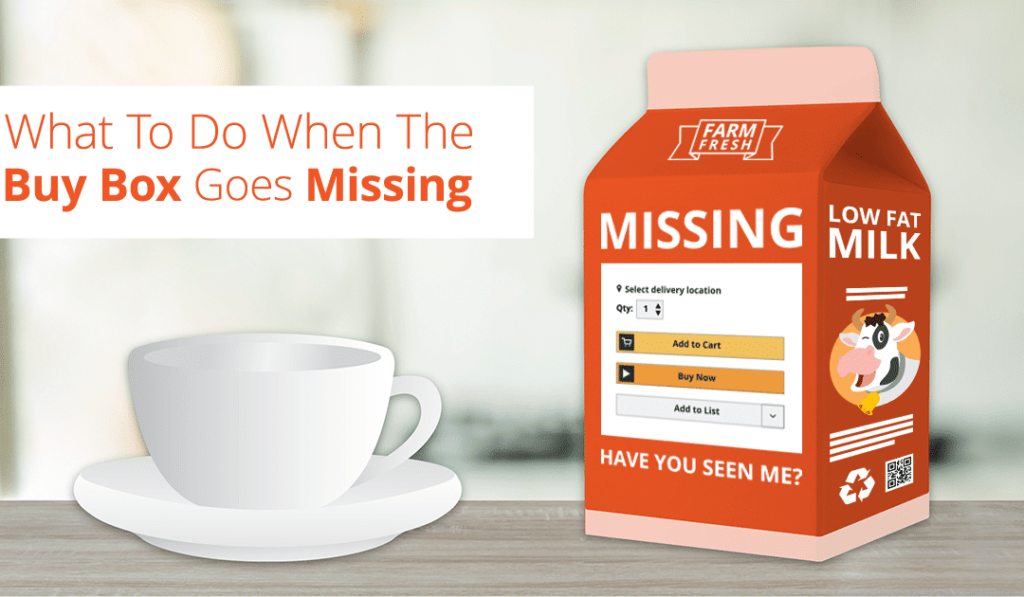
Did you know that more than 80% of all Amazon sales come from the Buy Box—the section on the right side of a product page with the Add to Cart button?
The Buy Box is the main source of sales on both desktop and mobile devices.
That’s why making sure that your offer is the one featured in the Buy Box is more important than ever.
But what do you do when the Buy Box is missing altogether? Why does this happen, and how do you get it to reappear on your listing?
Well, that’s exactly what you’re going to learn in this guide.
Why Is a Missing Buy Box Such a Big Deal?
Quite simply, a missing Buy Box makes it less likely that a sale will happen on that listing.
Here’s an example of a listing where the Buy Box has not been suppressed and is not missing:
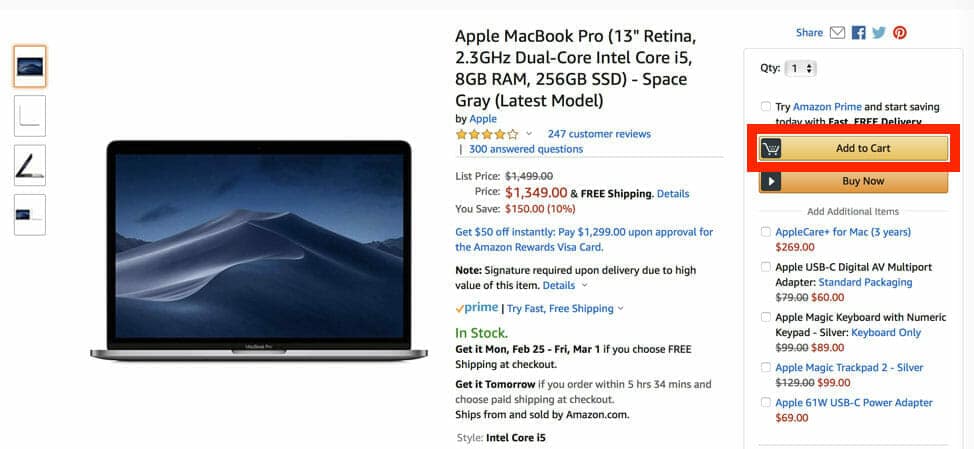
When a customer clicks “Add to Cart,” the seller with the best price and performance will usually be the one to have their product added to the customer’s cart. The “Buy Now” button below “Add to Cart” is the most direct path to a purchase on Amazon, requiring the fewest clicks on the part of users to make a sale.
Additionally, listings without a Buy Box do not get shown in Sponsored Products ads. Meaning, in addition to a lower conversion rate, you also get less traffic to your listing if the Buy Box is missing!
Keep in mind, this article is about the factors which cause Amazon to completely remove a Buy Box like one above from a listing, thereby hurting that listing’s conversions.
When a customer clicks on the “Add to Cart” button, only one seller can be that Buy Box-winning seller at any given time. The result is often fierce competition to land your listing in this lucrative position.
For the factors that help you beat other sellers for an existing Buy Box that isn’t missing, refer to this “Buy Box Cheat Sheet” from BigCommerce:
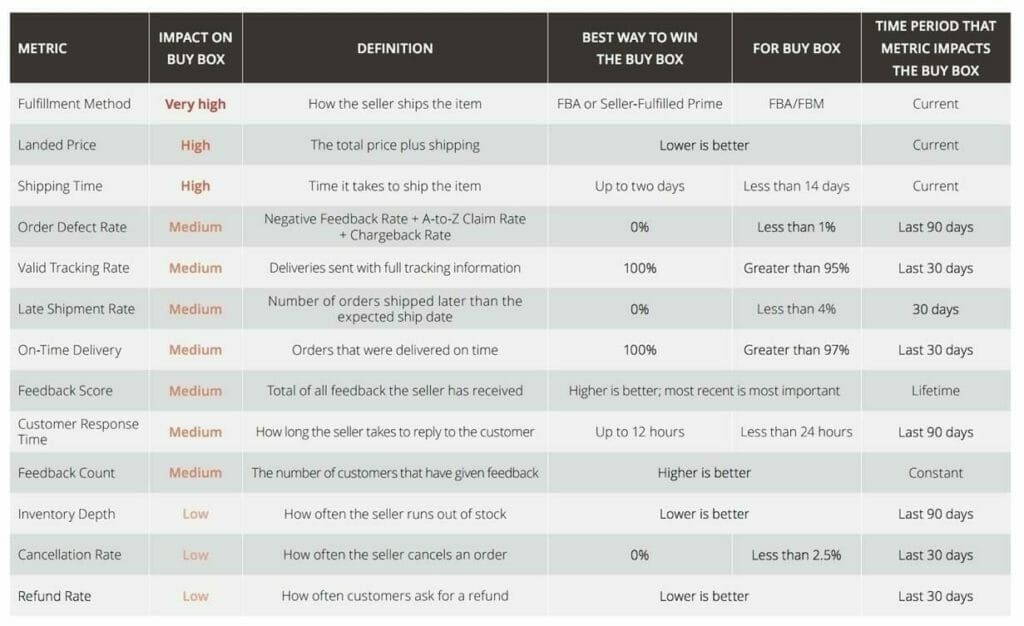
So, what does it look like when… there is no Buy Box at all to win?
Amazon removes the “Add to Cart” button from your listing, and displays “See All Buying Options” instead:
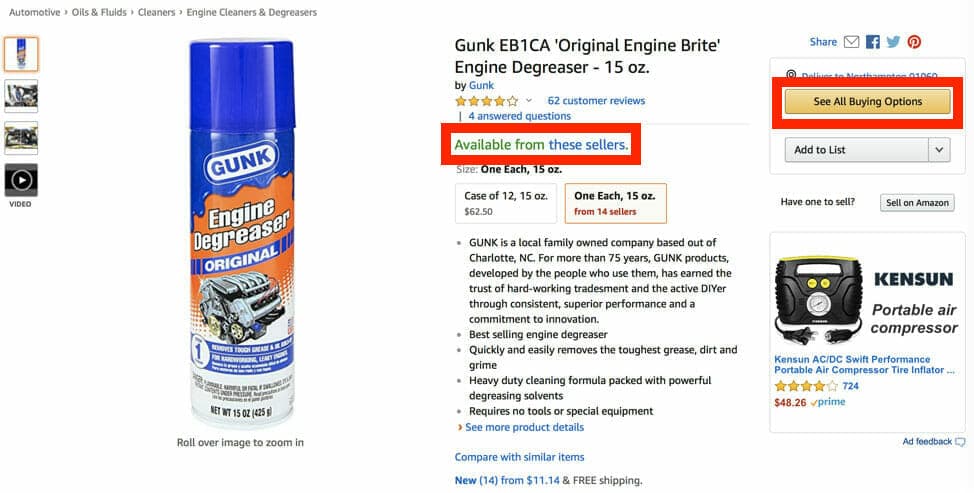
Notice the lack of an “Add to Cart” button. The customer must click on “Available from these Sellers” or “See All Buying Options” first, an extra hurdle that reduces conversions on that listing.
Only after clicking one of those buttons will Amazon show you the buying options (listed by lowest price + shipping) and allow a customer to Add to Cart:
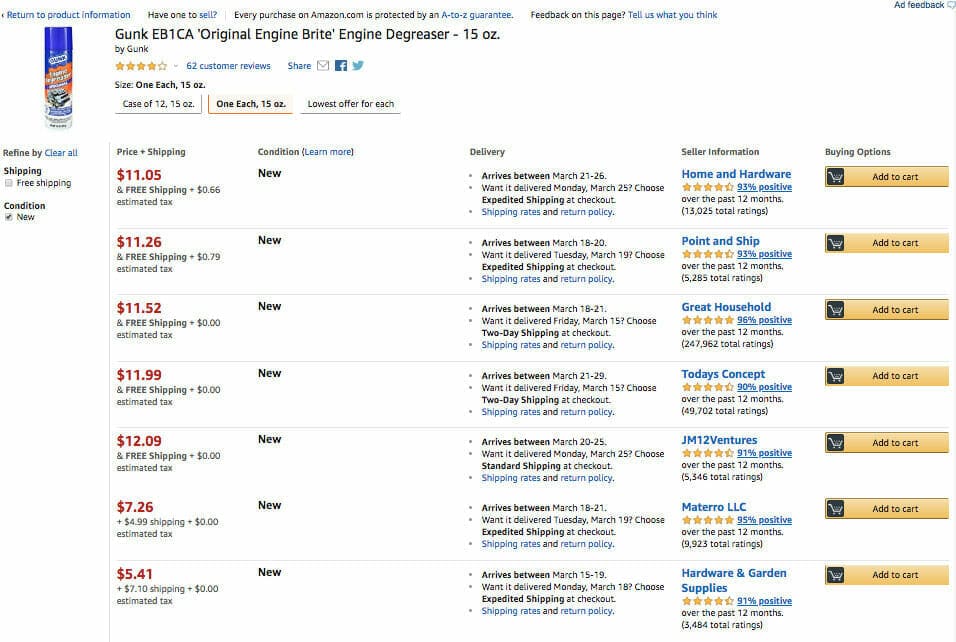
On the surface it might seem like a small difference, but don’t discount its importance.
Customers find it peculiar when “Add to Cart” isn’t an option on the product listing because they are accustomed to it being there. This extra step generally reduces customer conversion significantly, and leads customers to explore completely different competing products that do offer a Buy Box.
Buy Box suppression, as demonstrated above, is something that comparatively few sellers encounter. But if it does happen to you, it will keep you up at night worrying how you’re going to get the Buy Box back on your listing.
The good news is this: the common issues that lead to a missing Buy Box are relatively fixable.
To fix a missing Buy Box, though, you first need to know why Amazon is suppressing it.
Why Is Amazon Suppressing the Buy Box on Your Listing?
Although it might seem counterintuitive that Amazon would make it harder for customers to buy an item, there is usually a rational explanation.
Typically, it has to do with the price of the item. Remember, Amazon wants to make its customers happy by providing low prices.
If a product isn’t priced where Amazon thinks it should be, Amazon will often choose to disincentive a purchase and drive the customer to another product that’s priced more appropriately in the company’s eyes.
An Amazon spokesperson quoted in Inc. referred to the importance of pricing in causing a missing Buy Box:
“Sellers set their own product prices in our store. If a product is not priced competitively by a seller, we reserve the right to not feature that offer. Customers can still find all offers on the offer listings page.”
Pricing is perhaps the biggest factor that can cause Amazon to remove the Buy Box from a product detail page. But it isn’t the only factor. Concerns about a product’s authenticity or a seller’s ratings, or simply an error on Amazon’s part, can also cause a missing Buy Box.
Let’s explore the most common cases where Amazon will suppress the Buy Box feature on the detail page—and what to do in each case to get it back:
Causes of a Missing Buy Box on Your Amazon Listing
There are a number of potential causes of a missing Buy Box on Amazon. Let’s go through them step by step, and discuss what you need to do to address each cause and get the missing Buy Box back on your listing.
1. You’re a new third-party (3P) seller and/or are not Prime Eligible:
The first time most sellers experience a missing Buy Box is during the first 30 days after becoming a seller on Amazon.
Amazon uses those first 30 days as a testing period to verify your ability to consistently handle Amazon’s shipping requirements (which means no issues with order cancellations, late shipments, or confirming shipments).
Additionally, Amazon directs more traffic to Prime-eligible products. If your product is not Prime eligible and you are the only one offering the item, you may not get enough traffic to your product page to create enough order experience data that shows you can meet Amazon’s performance requirements. As a result, your listing doesn’t “evolve” to have the Buy Box.
For example, take this camping tent that is currently available only “from 1 seller.” It is not Prime eligible, and has no Buy Box:
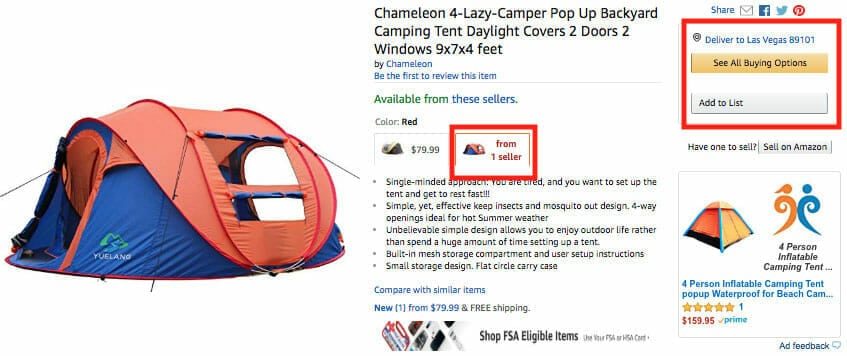
Clicking on “See All Buying Options” and looking under “Seller Information” gives us insight into the brand’s performance:
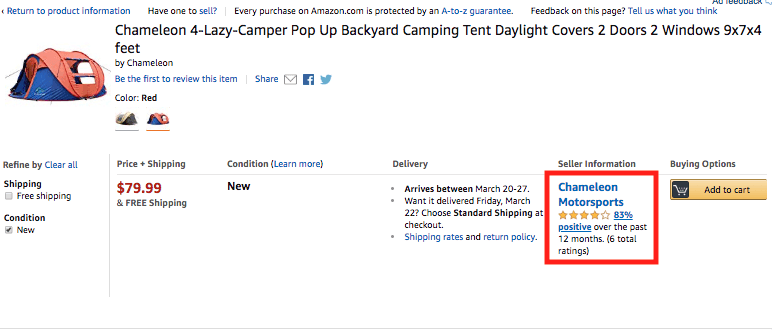
In 12 months, they’ve only gotten 6 seller ratings from all the products they sold to customers. Some of those ratings were bad, leading them to an 83% positive rating. Chances are, they haven’t made enough sales of this one product to show they can meet Amazon’s standards.
Strangely: the same tent, by the same brand, on the same page, in a different color, has its Buy Box available. Perhaps they have more sales of this color, but not the other:

How to resolve:
If you’re a new seller and want to win the Buy Box immediately, your best bet is to make your products Prime eligible through use of Fulfillment by Amazon or Seller Fulfilled Prime
While there are some situations where Prime eligibility doesn’t guarantee Buy Box eligibility on the product, most of the time this will work. Even without any order experience data.
2. Your product’s sales volume is too low
In addition to lack of performance data, as in the above scenario, Amazon may also remove the Buy Box from a product listing with a low sales volume.
We weren’t sure why this Movado watch listing had no Buy Box because:
- It is not new
- It has prime offers available
- It is not priced lower on other sites (it’s actually priced higher on other sites)
- It is priced lower than list price on Amazon
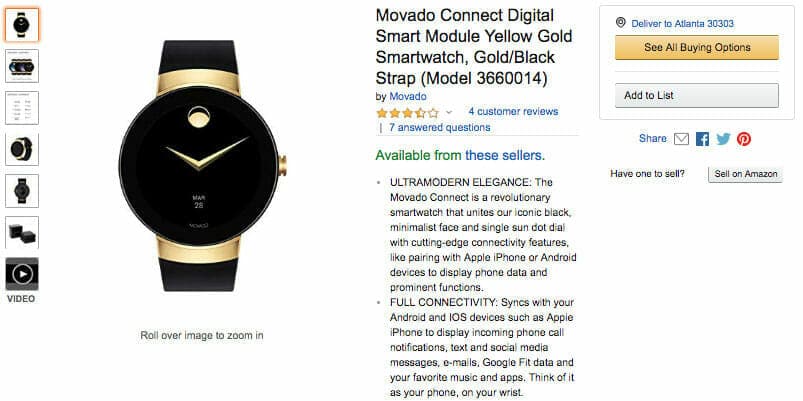
When we inquired with Amazon Seller Support, they told us that because units have been slow to sell, this listing has no Buy Box. Their response:
“ASIN: B077PF85L7 is not eligible as of this time for the Buy Box for the reason that this listings has shipped only 6 orders in the past 365 days. ”
So there are sales volume thresholds in place for products to receive the Buy Box.
Amazon would not indicate if these volumes were monthly or yearly based (although their initial answer of “# orders in the past 365 days” points to yearly). They also would not tell us what the minimum threshold is for a given product or if that threshold varies by product category.
How to Resolve:
Clearly, it’s important to ensure that your product is selling at a decent rate to avoid a missing Buy Box.
If your product should be eligible for the Buy Box but has received scant sales, send Amazon Seller Support a message to find the reason.
If it’s due to low sales volume, Amazon will send you a message like the one above.
3. Your product is less expensive on a third-party site:
Amazon has an army of servers that scrape competitive websites in search of lower prices. If those servers find an identical product on another site for a lower price, Amazon is then likely to suppress the Buy Box for that item on Amazon.
For example, this multipack of Ziploc bags is more expensive on Amazon than on Costco’s website:
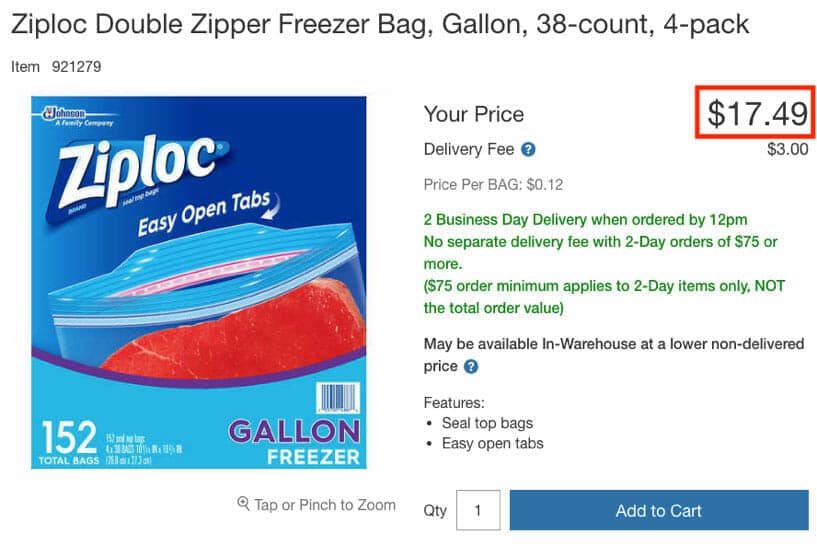
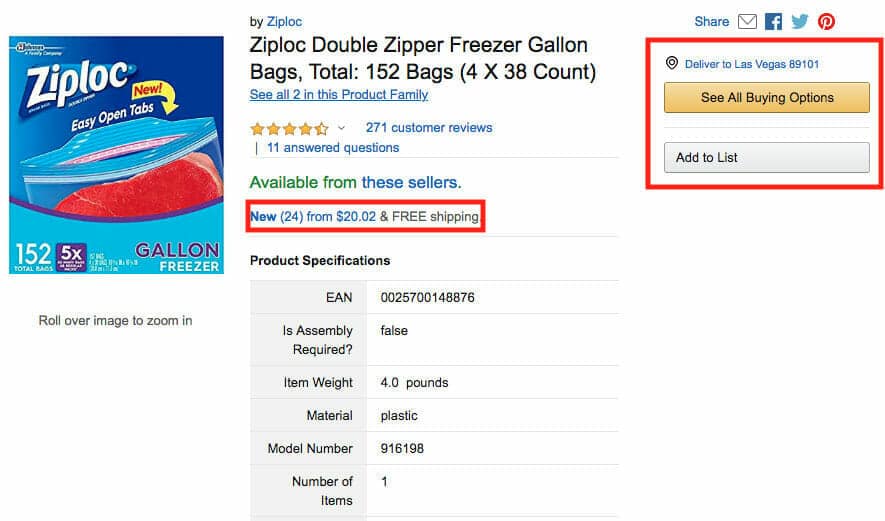
As a result, Amazon has removed the Buy Box from the product listing.
Removing the Buy Box when a lower-priced product is found off Amazon makes it less likely a customer will purchase it on Amazon. A missing Buy Box in this case is an effort by Amazon to protect the customer (and Amazon’s brand) from a negative experience where Amazon isn’t home to the lowest price.
Additionally, Sponsored Products ads stop and organic search rankings go down quickly when a product is has a missing Buy Box. As a result, Amazon features competing products more prominently.
If Amazon has 1P (first-party) inventory of the item, it may lower the price on it to match the competitive website. Sometimes, Amazon won’t lower prices on their own inventory, resulting in a missing Buy Box.
Often, a brand will update its prices across several vendors in addition to Amazon such as Sears, Jet, etc. While updating the price on Amazon often results in a same-day change, other vendors may take longer to update their prices. In the meantime, Amazon has already discovered the lower price on those other sites.
How to resolve:
It’s a harsh reality that this problem can’t be always fixed.
If you’re an Amazon third-party seller, this Buy Box suppression can be very frustrating. Individual sellers may have little to no ability to encourage the brand they are selling to stabilize pricing across various websites.
For example, most Amazon resellers are unlikely to be successful in trying to convince a brand to stop running a regional special on a smaller website, or to stop Costco.com from running a special on the product.
What if you’re a brand that wants to ensure that its products have Buy Box eligibility on Amazon? The first step is to avoid offering other channels discounts that aren’t simultaneously offered to Amazon 1P or Amazon 3P sellers. It’s worth reaching out to those non-Amazon vendors and asking them to expedite any pricing changes you’ve made on Amazon that haven’t shown up on those other sites yet.
That said, a brand may not be able to control prices of all their products carried by online retailers at any given time. Nonetheless, it’s still important for brands to keep an eye on their prices at various online retailers. Amazon certainly is, so brands need to maintain a similarly high level of diligence and adjust their pricing on those sites when necessary.
As of 2018, some brands have reported receiving a notification email from Amazon when the Buy Box is suppressed on one of their products because of a lower price on another site. That email typically looks something like this:
Hello [Seller Name],
One or more of your offers is currently ineligible for being a featured offer on the product detail page because those items are priced higher on Amazon than at other retailers.
To provide customers with a great shopping experience, we consider seller performance and price competitiveness to determine eligibility to be a featured offer on the product detail page. Your affected listings are still eligible for purchase on the offer listing page.
Your affected listings:
[AFFECTED LISTINGS]
Note that we are displaying a maximum of ten SKUs in this email.
Access your Brand Health page to review all your listings that are currently ineligible for being a featured offer on the product detail pages due to price competitiveness.
Next step: To restore eligibility to be a featured offer on the product detail page, access your affected listings from the Brand Health page, update the price and shipping cost of your affected listings to be equal to or less than the competitive prices.
Sincerely,
Selling on Amazon Team
The email suggests visiting the Brand Health page in Seller Central and adjusting the price of the product to the level Amazon recommends. The problem is that this price level may be lower than you’re comfortable, leaving your brand in a predicament.
4. A product similar to yours on or off Amazon is less expensive:
Companies selling on Amazon are confounded when they offer a unique product there at the lowest price, yet it still has no Buy Box.
It turns out that sometimes, Amazon compares prices of a product to another site’s prices on similar but not identical items. That “sometimes” is almost always an arbitrary decision made by an individual Amazon Vendor Manager or a calculation by Amazon’s bots.
For example: if one brand’s camping tent is selling well on a different site, and Amazon or a 3P seller carries a very similar camping tent by another brand, Amazon may decide the two products are similar enough that the higher-priced tent on Amazon is uncompetitive. If the Amazon offer is controlled by 1P or 3P, Amazon may choose to remove the Buy Box.
Another version of this problem happens when a unique multipack is sold on another site and Amazon 1P decides to apply unit pricing to its multipack. For instance, Costco.com sells an exclusive 10-pack of a SKU, while Amazon has a 6-pack. If the price per one pack on Amazon is higher than the price per pack on Costco.com, a Vendor Manager may see the pricing difference for one pack outside of the context of a multi-pack and suppress the Buy Box.
How to resolve:
Honestly, this one is not so easy to proactively prevent or find a root cause for. While some brands will sell essentially the same product in different channels under different SKU names, what we are dealing with here is driven by arbitrary decisions made by individual Amazon employees, rather than designed confrontation by a brand toward Amazon.
If your products aren’t priced lower elsewhere, contact Amazon’s seller support and explain that your specific product’s SKU is available at the lowest price via Amazon, and request that the Buy Box be enabled for that product.
Sometimes Amazon will add back the Buy Box right away. Be prepared for other times, when it may take some follow-up on your part to work your way through the support chain and reach the person who ultimately changes the listing.
5. Your product’s Amazon price is higher than the MSRP:
When a third-party seller offers a product at a higher price, typically more than 5% higher than the list price that Amazon has in its catalog, Amazon will suppress the Buy Box for that individual seller.
List price is also known as the manufacturer’s suggested retail price (MSRP), recommended retail price (RRP), or suggested retail price (SRP).
If multiple sellers are selling a product above list price, then the Buy Box will be suppressed for everyone, as it was for these sellers offering a $37 bottle of laundry detergent:
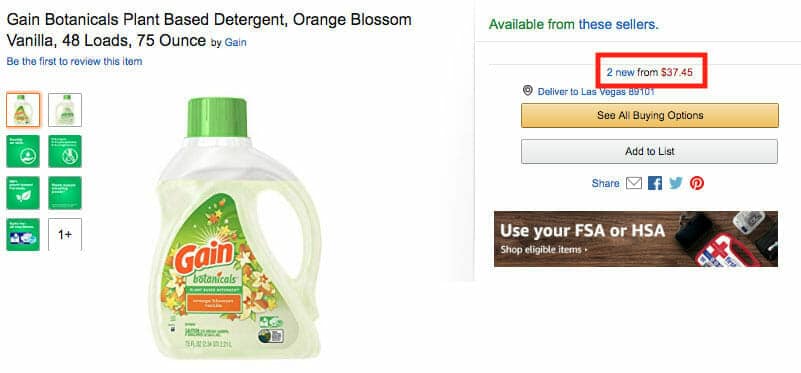
Basically, this is a mechanism that Amazon has put in place to prevent price gouging. Think of what happens in December for popular children’s toys: Amazon doesn’t want to reward sellers for selling hot products well above list price. So, Amazon suppresses the Buy Box as a bottleneck to slow down customers’ interest in buying the product.
When there is no Buy Box, customers may wonder what’s wrong with the offers available (and possibly move on to other products that don’t have suppressed Buy Box conditions).
How to resolve:
A couple of easy fixes are available.
If you’re a third-party seller, don’t raise the price on your product when inventory is low, as tempting as it may be.
If you’re a brand, encourage the sellers of your product on Amazon not to raise the price on it as the inventory gets lower (or for any other reason).
Don’t sell above the product list price. You can avoid adding list price information in your data feeds—if there is no list price in the Amazon catalog, there is nothing to compare the selling price to.
• One important note to consider: if the product you are selling is no longer available from the manufacturer, you can file a ticket with Amazon to have the list price removed. Prove it to Amazon by showing them the manufacturer site where the item is no longer available or marked as discontinued. This makes it more likely that your higher-than-list-price offer will become Buy Box eligible again.
6. Amazon is reviewing your product’s authenticity:
Rather than pull a product, Amazon will sometimes suppress the Buy Box while it’s reviewing authenticity complaints received from customers, such as complaints about falsely labeled fashion apparel.
If there is a sudden rush of complaints, Amazon will want to validate that there isn’t a problem with the available inventory from all sellers, so it may slow down sales of the item during this inspection period.
How to resolve:
Did you receive a Product Authenticity Complaint from a customer? If you are selling authentic product on Amazon, there really isn’t much you can do beyond reaching out to the customer and to Amazon.
If you didn’t get a notification about the situation from Amazon, inquire with them about the cause of the missing Buy Box. The complaints may be coming from sales by a competing seller offering the same listing. It’s entirely possible that you may get caught up in a situation like this that you didn’t cause directly.
7. Amazon 1P isn’t able to procure selection from the brand
On top-selling items that Amazon 1P has been selling recently, we have seen situations where Amazon will remove the Buy Box for all sellers until Amazon 1P is able to get the product back in stock.
Unlike situations where 1P may be temporarily out of stock, in this situation the brand has usually told Amazon 1P that it no longer wants to wholesale the product to them. In response, Amazon 1P basically retaliates, and hurts the brand’s ability to generate sales on Amazon by removing the Buy Box.
How to resolve:
If you’re the brand wholesaling to Amazon, be aware that if you communicate to Amazon that you’re pulling 1P inventory, the individual Vendor Manager may retaliate by removing the Buy Box. It’s probably better not to communicate with Amazon 1P this way, and simply designate the item in Vendor Central as “temporarily out of stock.”
If you’re a third-party seller with an offer on the item: Amazon 1P’s actions are hard to prevent, and your offer is basically an innocent victim in the middle of a fight between 1P and the brand—so there’s very little you can do here.
8. Your seller rating has dropped:
When a seller on a listing has performance issues, and its trailing 30-day seller ratings drops below 90% (or so), we often see that seller lose its Buy Box eligibility.
If that seller has the only offer on the listing (such as a brand selling its own product), then the listing will also lose its Buy Box. This might have been the case with our first camping tent brand example from earlier:

How to resolve:
If you’re the seller, check to make sure that all of your recent seller ratings are legitimate seller ratings, and not product-related ratings or FBA-related issues.
If the issues are not related to the seller’s shipping or customer service (such as negative customer feedback on the actual product or FBA’s shipping performance), file a Seller Support ticket to challenge the feedback. Potentially, it will be struck from your account, and hence from your trailing 30-day seller ratings average:

Removal of bad seller ratings can help drive up your average seller rating and move you back into Buy Box eligibility.
If you’re the brand, and all of the sellers on one of your Amazon listings are not eligible due to their seller rating / performance issues, it’s likely time to find some more highly-performing sellers to represent your products on Amazon.
Reviewing your sellers on Amazon periodically is a good idea. Poor performance on seller ratings is likely a sign of other inherent business problems for the seller.
9. Your listing is broken, and Amazon needs to fix it:
Even after all of these above scenarios, there may be situations where none of them apply, and the issue is simply that Amazon’s listing software isn’t working the way it’s supposed to.
How to resolve:
If you’ve ruled out all of these earlier explanations, you can contact Seller Central by phone and ask to be put in touch with the CAPTIVE team. Have your ASIN handy and explain that the Buy Box doesn’t appear to be working properly, then ask that team to re-drive the listing.
10. Your newly listed product hasn’t been activated for Buy Box eligibility due to a mistake or glitch:
For whatever reason, sometimes new listings never get activated with a Buy Box, even though the seller and offer both should be eligible for a Buy Box.
We have worked with brands that have launched a product on Amazon that’s being offered for sale by other sellers who are otherwise eligible to win the Buy Box, and yet the product never gets the Buy Box (and none of the earlier explanations apply on why the Buy Box might not be showing up).
How to resolve:
Contact Seller Support, and file a ticket asking for a review of the product’s Buy Box eligibility.
Mistakes and glitches can certainly happen on Amazon, so the fastest route to getting attention on the item is to file a Seller Support ticket.
11. Your product’s price is being undercut by a previous promotional price:
If your product was priced lower for a temporary sale or promotion, and then goes back to its normal price, Amazon’s automated algorithm may look at that pricing history and mistakenly determine that the current price is uncompetitive.
This is likely to occur if you’re the only seller (e.g. the brand seller) for an item. If you run a sale on your item for a little while, then set it back to the original price, the sale price sets a precedent that causes you to lose the Buy Box.
We’ve worked with sellers who have run a promotion causing Amazon to assign that promotional price to the product’s internal designation list price. They were then forced to lower their normal price or lose the Buy Box.
How to resolve:
Carefully review your product’s pricing information when you input it into Amazon’s listing manager. If you raise the price, try doing so incrementally, such as 2% over several days until the pricing is back to its normal level.
If you run a promotion, use Amazon’s built-in promotion options to allow customers to redeem a coupon (which can be displayed on the product listing page for instant redemption) rather than manually lowering the price on the product.
Otherwise, once you adjust the pricing back, Amazon’s bots may interpret the lower price of the promotion as what the product “should” be priced at.
12. Multiple factors may be at play:
When it comes to physical goods, there are odd occurrences that happen sometimes. For example, a combination of factors could be causing a missing buy box.
As with this mini fridge:
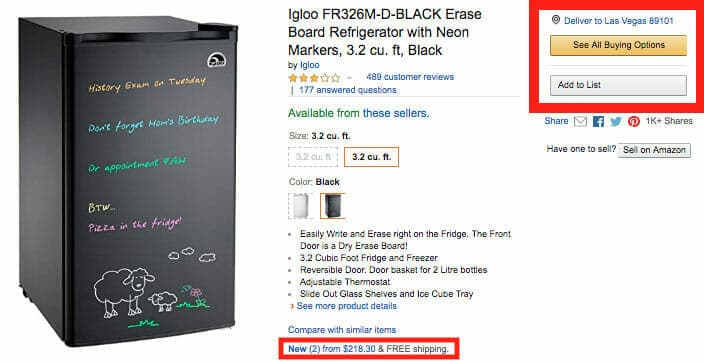
Notice the higher price for this product on Amazon and missing buy box, compared to the lower price on Home Depot:
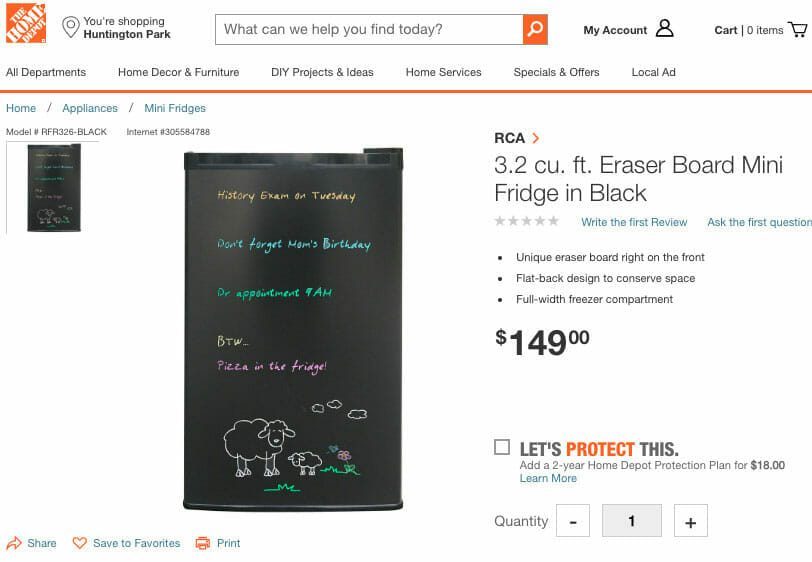
Is it a case of an identical product cheaper elsewhere, or Amazon deeming them to be similar products with a cheaper option off Amazon?
Another possibility is a broken listing from the discrepancy in the listing’s brand name and model number between the two sites. “RCA-Igloo” is the correct brand, but only half the name appears on each listing on each site as “RCA” or “Igloo.”
Either way, Amazon doesn’t see its own listing for this product as legitimate or competitive, and rightly so.
How to resolve:
- Take steps to address each possible factor:
- Correct any product information discrepancies on Amazon
- Offer a lower price than anywhere else
- And as always– try to make sure your product is Prime eligible through FBA or seller-fulfilled Prime.
- After taking any action yourself, send Amazon seller support a message to make them aware of the changes you made and ask them to add the Buy Box to the listing.
When It Comes to the Buy Box, You Have More Control Than You Realize
Buy Box Eligibility is crucial to your success on Amazon. Every seller should review its products on a regular basis to check that the “Add to Cart” button is available on each listing.
While some of the problems holding back Buy Box Eligibility are caused by forces outside of the seller’s control, most issues can be influenced by the brand and its choice of behaviors both on and off the Amazon channel.
To recap, the minimum of what you should do to maintain an active Buy Box is:
- Sign up for FBA or Seller-Fulfilled Prime to make sure your products are Prime eligible
- Maintain price parity between Amazon and your other vendors, and/or make Amazon the lowest price
- Review your seller performance and take steps to improve it
- Review your listings for any mistakes or errors
Remember that most of the issues that can lead your listing to lose the Buy Box are much easier addressed before they happen, so continue to be proactive in fighting for your right to win the sale. Don’t be shy about contacting Amazon to take action for you on a listing.
As a brand operating on Amazon, it’s easy to spend too much time and effort navigating Amazon’s platform and policies.
At Buy Box Experts, our team capitalizes on their combined years of experience and successful track record to help brands maximize their success at every level on Amazon.
Get in touch with us today to see if we’re a fit to help your brand succeed on the world’s largest ecommerce marketplace.

If you’re one of the estimated 20%–40% of brands who fire their agency annually, you can’t focus on that vision if you have to keep searching for the right support. BBE proudly retained >95% of our clients last year while applying focused dedication to our brand partners. If you’re ready to start over for the last time, contact us and find out why leading brands have partnered with us for so long.

